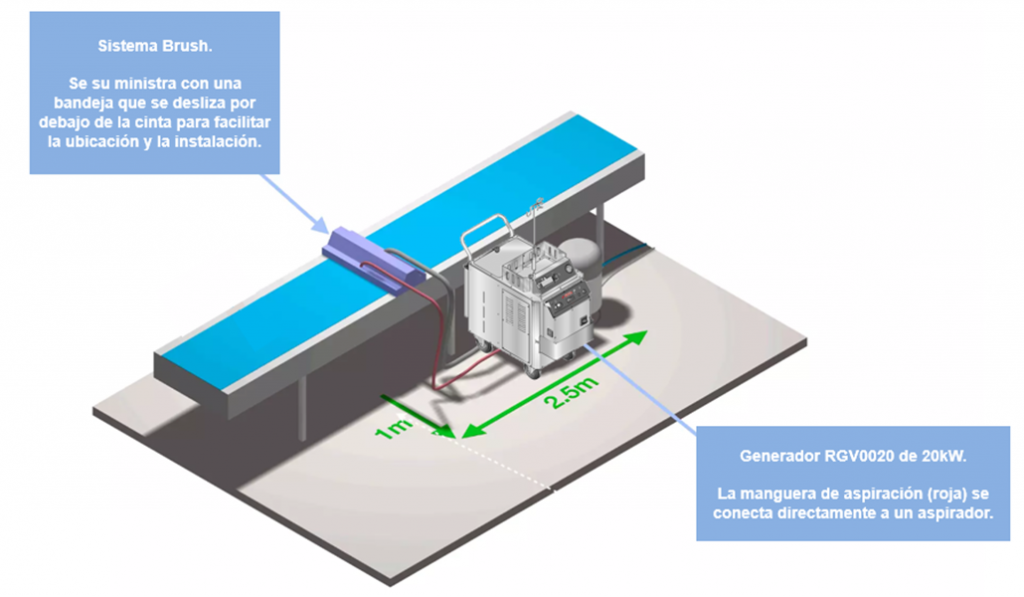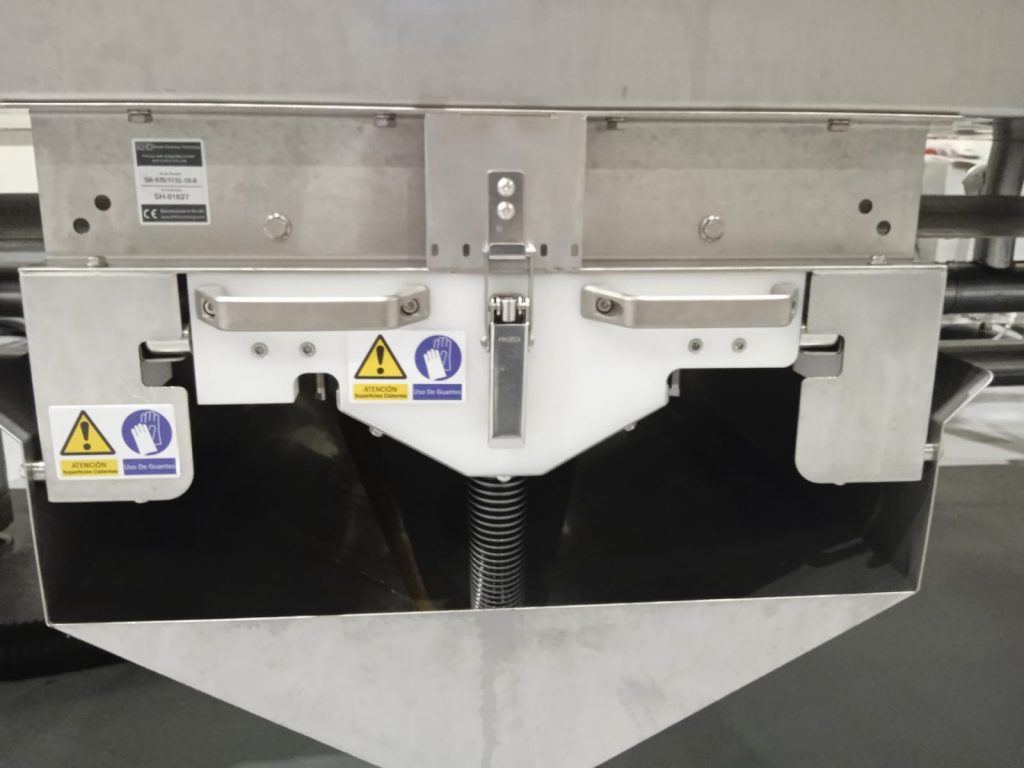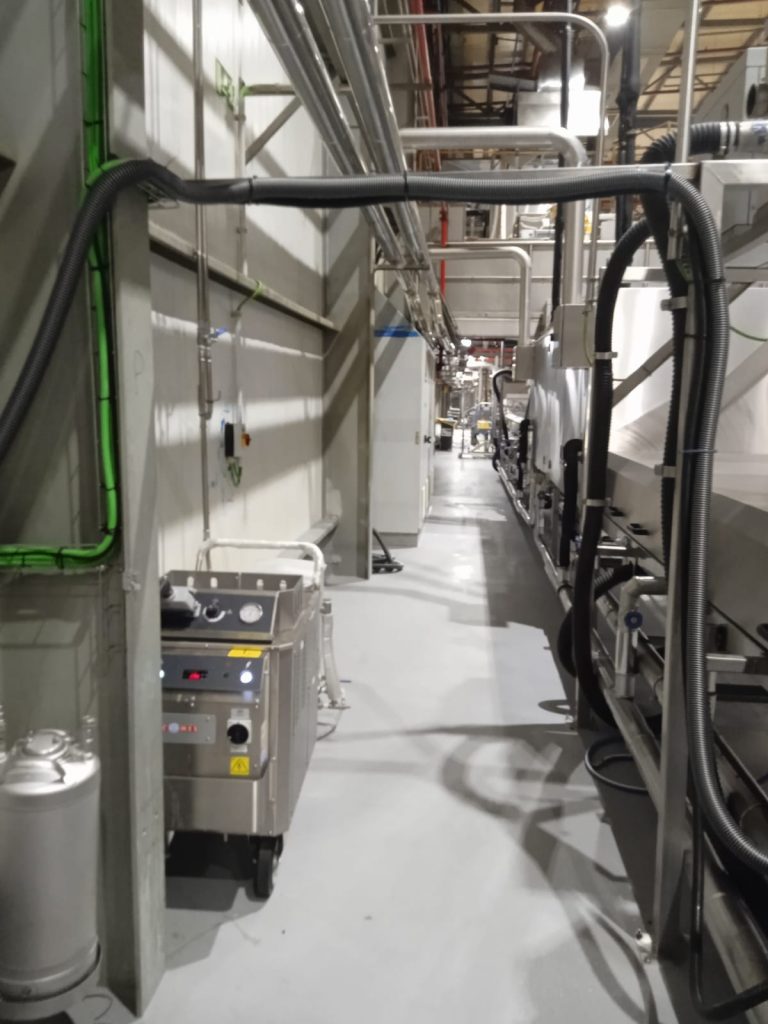Success stories
Food industry automation
Project Description
Implementation of an automated steam-powered cleaning system for the conveyors(Brush). This project has been designed to optimize efficiency, reduce dependence on manual labor in cleaning tasks and, fundamentally, raise the quality standards of the process.
Original situation:
Challenges posed by the client:
The main requirement was to achieve optimum continuous cleaning for a canvas conveyor belt in the production of energy bars. The customer needed to keep the conveyor constantly clean without interrupting production and there were also limitations on water consumption.
Resources used:
- High-pressure washers (x2)
- Detergents
- Labor (2 workers, 8 hours per week)
Issues:
- Ensure conveyor cleanliness without interrupting production
- Reduce water and detergent consumption, as much as possible.
Proposed solution:
Customized steam solution developed by Giconmes.
Proposed solution:
The essence of this project lies in the integration of an automation system that takes care of cleaning the conveyors autonomously and without interrupting production, eliminating the need for human intervention in this specific task. This change not only frees up human resources for more specialized functions, but also ensures consistent and thorough cleaning at all times, improving hygiene and overall product quality.
The star component of this initiative is the use of steam for cleaning. By powering the automated system with steam, the plant has achieved a 90% savings in water consumption, a significant milestone in the quest for more sustainable and environmentally friendly practices. The efficiency of steam not only ensures thorough cleaning, but also contributes to the conservation of water resources.
Ultimately, this project is a testament to the ability of automation to transform not only operational efficiency but also sustainability and product quality. By adopting this solution, the food plant has positioned itself at the forefront of the industry, leading the way to a future where operational excellence and high quality standards go hand in hand.

Technology used:
- Brush system
- Generator RGV0020
- Industrial vacuum cleaner for the removal of coarse residue



Savings:
Return on investment in 14 months
We eliminate the need to make stops for cleaning tasks, increasing the hours available for production.
Reduction of water consumption by 90%, including the elimination of any chemical products.
8h x 52 weeks x 19.5 = 8,112 x 2 persons = 16,224/year (staff resources saved)
Do you need a customized solution?
We help you define what type of installation you need
FAQs
We understand that many questions may arise. Here are some of the most common ones.
There are no emissions beyond those produced during the electricity production process. Consequently, emissions can be neutral depending on the electricity mix. Electric steam boilers are the present and the future.
Absolutely. In fact, it is recommended to achieve maximum efficiency. There is no problem with remote control as long as it complies with current regulations.
A steam generator is a pressure vessel that, together with the piping network, is subject to regulatory control and complementary technical instructions, according to the regulations published in Royal Decree 809/2021, of September 21. Maintenance is divided into a part that can be easily fulfilled by the owner:
- Know and apply the manufacturer’s instructions regarding use, safety measures, and maintenance.
- Not to put the installation into service or prevent the operation of pressure equipment if the requirements of the Regulation are not met.
- Having at least the following documentation for the pressure equipment while they are installed: Declaration of conformity, manufacturer’s instructions (if applicable), and, if necessary, installation certificate, along with other supporting documentation (such as installation project, record of the last periodic inspection, certifications of equipment repairs or modifications, and any other documentation required by the relevant technical instruction complementary to this regulation). For detailed contents, refer to Annex IV of the regulation. Making this documentation available to the competent authority of the autonomous community and the companies responsible for maintenance, repair, or periodic inspections.
- Use the pressure equipment within its intended operating limits as specified by the manufacturer and take it out of service if it no longer meets the necessary safety requirements.
- Perform maintenance on the installations, pressure equipment, safety accessories, and control devices in accordance with the operating conditions and manufacturer’s instructions, and examine them at least once a year.
- Arranging for the necessary periodic inspections as required by Article 6 of the regulation.
- Having and maintaining an up-to-date record of pressure equipment categories I to IV, as defined in RD 709/2015, of July 24, or equipment similar to these categories according to Article 3.2 of the regulation, as well as their installations.
It is known that by applying heat to water, it transforms into steam at the boiling point and atmospheric pressure. From there, depending on the required saturation degree of steam for its proper application, we need to increase the pressure to obtain a higher temperature. To change the temperature and saturation degree of steam, we always need to modify the pressure.
It is a unit of pressure equivalent to 1 kg/cm2, 0.98 atmospheres, or 14.50 PSI.
Haven't found the answers to your questions?
Please send us a question or download all the information
USES OF STEAM IN INDUSTRY AND OTHER BUSINESSES
Other similar success stories using steam

The use of steam is gaining popularity in various industries due to its effectiveness and environmental benefits..
In our "Success Stories" section, you can discover more about companies that have adopted this technology and have achieved successful results in terms of efficiency and sustainability. Click on the success stories to learn more details.